Creating a summer open-gym regimen that gets results
Offseason open-gym workouts — in which specific skill areas are focused on — have proven critical in preparing our teams for the following season.
There was a time when we wanted to play as many summer-time games as possible. A couple of years ago, however, we concluded that our players’ most important skills seemed to weaken with every additional game played. Players loved the games, but they lost sight of the importance of also picking up a basketball and performing individual workouts to improve their skills. It was obvious when the season began that players hadn’t progressed far enough in improving their skills.
Playing games during the summer months is beneficial as long as the purpose of these games is understood — allowing players to test the skills they’ve been honing during their open-gym workouts. Summer games also provide an avenue for us, as coaches, to help players understand their roles on the team, try a new style of play (especially at the high school level, where we’re dealt “a new hand” of players every year), and to teach the dynamics of game-like situations. But if the purpose of summer games is unclear to coaches or players, a team most likely lags behind on the core fundamentals of the game. When this is the case, the Xs and Os don’t seem to matter much.Open-gym agenda
We change summer open-gym workouts each year to address the specific mix of players returning for the following season. Our program’s open-gyms focus on fundamentals, with very little time spent on 5-on-5 basketball.

This article summarizes a portion of what players can focus on for the two-and-a-half hours they’re in the gym. The fundamentals are broken into the five critical areas. Team captains know they must do at least one item from each section during every open gym:
- Ball handling
- Shooting
- Transition
- Offensive skills
- Defense
Ball-handling
Ball-handling drills are run for 10 to 15 minutes in every open gym. Each of these drills was borrowed from college programs from all over the nation.
∞ Cone dribbling. In this drill (DIAGRAM 1), nine cones are set on the floor. On the four-cone side, players dribble with one hand and weave in and out. On the five-cone side, each player works on his or her crossover. At the end of either line, the player shoots a layup or short jumper. They then switch lines.
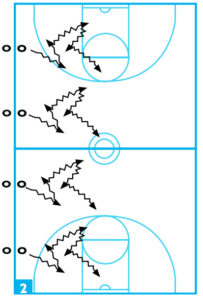
∞ Trojan dribbles. Four or five cones (or chairs) are placed down the length of the court. Players can use dribbling glasses to reinforce keeping their heads up. In groups of three, each player performs the following drills three times and back (also helping with conditioning).
∞ Two-ball dribble. In this drill, players are put in groups of three or four. Each player dribbles two basketballs at once down the full length of the court. Each time down the floor, players focus on one of the following:
- Speed
- Alternating dribbling hands
- Simultaneous dribbling
∞ Utah Drill. This drill is run sideline to sideline (DIAGRAM 2). The player takes two forward dribbles followed by two back-up dribbles to simulate dribbling out of a trap. Emphasize staying low on the back-up dribble and gaining the space needed to beat a trap. Then, the player does a crossover dribble and takes two dribbles the other direction. The sequence is repeated until players reach the other sideline.
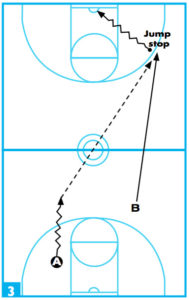
Transitions
The following are three open-gym drills to improve your players’ transition game.
∞ Sits. This drill is done in pairs. Player A starts below the free-throw line on one end of the court, facing the opposite end. Meanwhile, player B starts ahead of A, just beyond the 3-point. line. A takes two dribbles toward the other end of the court, while B sprints down the side of the floor. A makes a long transition pass to B, who catches the ball and “sits down” in a jump-stop (so as not to travel) and then shoots a layup (DIAGRAM 3).
The players switch positions and repeat the drill coming back downcourt.
When each partner has made six layups, the pair moves on to the next shot, which includes:
- One-dribble jumper
- A dribble-to-free-throw-line jumper
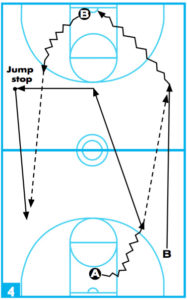 3-ball and 1-on-1 move
3-ball and 1-on-1 move
This is a competitive drill, with each pair aiming to be the first to complete the entire circuit.
∞ Pitch ahead (partner drill). With the same starting formation as the “sits” drill, player A throws the ball off of the glass, catches it and takes two or three dribbles. At the same time, player B runs the sideline, and catches A’s pass in stride for a layup. Once A makes the pass, he or she runs to the top of the key on the opposite end of the court and then to the sideline (jump-stop and open up).
After B rebounds the shot, the pair runs the drill back the other way, this time with B passing to A. Each player must make three shots to complete the drill. The drill is then repeated with a pull-up jumper (DIAGRAM 4).
∞ 2-on-2 continuous. In this 2-on-2 full-court drill, one pair shoots the ball to start the game.
The game is played until a basket is scored, or four trips are made down the court. The team that scores or makes the last stop stays on the floor and another twosome steps in (DIAGRAM 5).
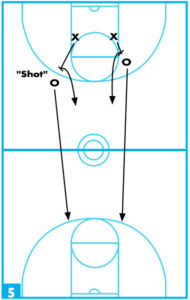
Shooting
Shooting is emphasized a great deal in open gyms. While many shooting drills are available, here are five of our favorites.
∞ Post 30-seconds triangle shooting drill. Three balls are placed in the lane as shown. Player 1 is a rebounder while players 2, 3 and 4 are located near the balls. Each of these three players will receive the ball from the rebounder and place it down on the floor for the shooter (player 5).
The post shooter has 30 seconds to make as many shots as possible. Players keep track of their scores in this drill (DIAGRAM 6).
∞ Trojan ‘20.’ In this game-speed drill, a player must make five 3-pointers from four different spots on the floor (DIAGRAM 7). Players are to simulate coming off a screen by spinning the ball in the air and catching it off one bounce. A passer also can be used.
Players should keep track of how many attempts it takes to make five shots from each spot. The total attempts are scored and charted to measure progress.
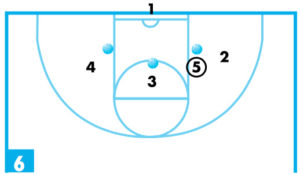 This drill also is run with other types of shots, including field goals off the dribble, from 15 feet, etc. Guards should work on their step-back-and-shoot moves.
This drill also is run with other types of shots, including field goals off the dribble, from 15 feet, etc. Guards should work on their step-back-and-shoot moves.
∞ Competitive partner shooting (two players). A player shoots game-type shots (including layups) for 30 or 60 seconds, keeping track of the number made. Then, it’s the second player’s turn. The drill is run for three to four rounds, with consequences for the player with the lower score.
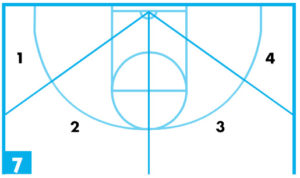 ∞ Trojan post moves. Post players simulate receiving a pass by spinning the ball to themselves in the block. They then make a skip pass to the opposite wing, follow their pass and post up.
∞ Trojan post moves. Post players simulate receiving a pass by spinning the ball to themselves in the block. They then make a skip pass to the opposite wing, follow their pass and post up.
Each player shoots 10 shots for each of the following post moves:
- Drop-step baseline
- Inside drop-step jump hook
- Turnaround jumper
 Up and under
Up and under- Spin move
∞ Three-player rotation drill. Player A and B each start with a basketball. A shoots (1), rebounds (2) and passes to C (3) before cutting to a new spot (4). After A shoots the ball, B shoots, rebounds and passes to A, who is ready to shoot again. C shoots, rebounds and passes to B (DIAGRAM 8).
This sequence continues with players moving to new spots on the floor and calling for the ball.
Offensive skills
Here are five offensive drills to incorporate into summer open gym sessions.
∞ Two-player playground drills. These “make-it, take-it” drills are usually run for one minute or to a specified score. They can be run in two different versions. In the first version, the defensive player passes to the offensive player from various spots on the floor. The offensive player has only two dribbles to get a shot off.
In the second version, the offensive player starts with the ball but cannot attack until the defender has touched the offensive player on either hip.
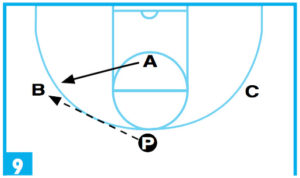 ∞ 2-on-2 screen shooting (guards). Run “live” at game-speed, this drill works on reading screens. Players take the positions that they would in the normal offense. The offensive player passes and sets a screen. Playing “make-it, take-it” keeps the defense playing tough.
∞ 2-on-2 screen shooting (guards). Run “live” at game-speed, this drill works on reading screens. Players take the positions that they would in the normal offense. The offensive player passes and sets a screen. Playing “make-it, take-it” keeps the defense playing tough.
∞ 2-on-2 block-to-block shooting (post). This drill teaches post players to help each other get open.
Position a passer at each wing. The posts must work to get open by screening for each other. They can’t leave the post except to come to the top of the key to look for the high-low opportunity or to reverse the ball.
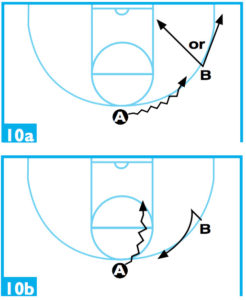 ∞ 1-on-1 drill. Player A is on defense. The passer, at the top of the key, quickly passes or rolls the ball to either B or C. A closes out, and defends the player with the ball 1-on-1. If A makes a stop, he or she is out and the offensive player goes to defense (DIAGRAM 9).
∞ 1-on-1 drill. Player A is on defense. The passer, at the top of the key, quickly passes or rolls the ball to either B or C. A closes out, and defends the player with the ball 1-on-1. If A makes a stop, he or she is out and the offensive player goes to defense (DIAGRAM 9).
∞ Penetrate and kick (guards). Player A is at the top of the key with the ball and B is at the wing. If A dribbles at B, then B goes to the basket or fades to the corner. If A dribbles down the lane, then B fills in behind for the shot. Players alternate positions after each shot (DIAGRAMS 10A-B). The first one to make a specified number of baskets wins.
Other offensive drills to run during open gyms are 3-on-3 half-court, 4-on-4 full-court with no dribble and 4-on-4 full-court with the dribble.
Defensive drills
Here are four defensive drills to incorporate into open-gym play.
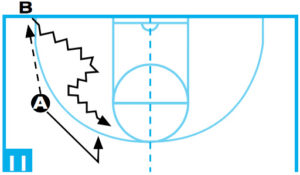 ∞ Competitive full-court 1-on-1. Player A passes the ball to B, who attempts to dribble downcourt, using only half the court’s width until they reach the half-court line. Once at midcourt, B can work the full width of the floor to score. A must try to keep B out of the middle of the floor (DIAGRAM 11).
∞ Competitive full-court 1-on-1. Player A passes the ball to B, who attempts to dribble downcourt, using only half the court’s width until they reach the half-court line. Once at midcourt, B can work the full width of the floor to score. A must try to keep B out of the middle of the floor (DIAGRAM 11).
∞ Rush Drill. This drill is set up like the competitive full-court 1-on-1 drill, except that after the defender passes the ball to the offensive player, he or she runs to the half-court line before trying to stop the offensive player.
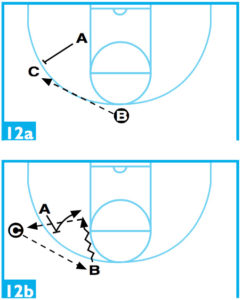 ∞ Help-and-recover drill. Player A is the defender and starts on the low block. When B passes to C on the wing, A closes out. The ball is then passed back to B at the top of the key, who drives to the basket.
∞ Help-and-recover drill. Player A is the defender and starts on the low block. When B passes to C on the wing, A closes out. The ball is then passed back to B at the top of the key, who drives to the basket.
Player A must jump to the pass and stop the dribble penetration. When A stops the ball, B kicks it back out to C on the wing, where A must help and recover before playing C 1-on-1 (DIAGRAMS 12A-B).
∞ Superman Closeout Drill. After the defender passes the ball out to one of the four players on the perimeter, he or she works to close out on the player with the ball (DIAGRAM 13). Each offensive player on the perimeter has only two dribbles to score. After the shot, the defender works on box-out technique.
Bringing it all together
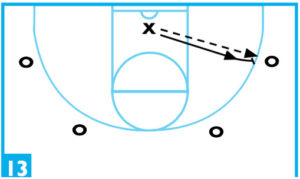 These drills are never all covered during a single open-gym session. Instead, they are varied to avoid monotony. This program is effective since players enjoy coming in and working on their game, and because there are enough competitive drills to keep them fired-up.
These drills are never all covered during a single open-gym session. Instead, they are varied to avoid monotony. This program is effective since players enjoy coming in and working on their game, and because there are enough competitive drills to keep them fired-up.
The itinerary for the open-gym sessions is made by the upperclassmen. They are given a list of drills and told to organize an outline for each session. This gives players ownership in making the team better.
Chad Cluver is the head boys basketball coach at Watseka Community High School in Illinois. He previously spent 16 seasons coaching at Maroa-Forsyth High School (Illinois), where he compiled a 269-186 record and won one state championship. His guide to summer open-gyms was published in the 2004 May/June issue of Winning Hoops.









